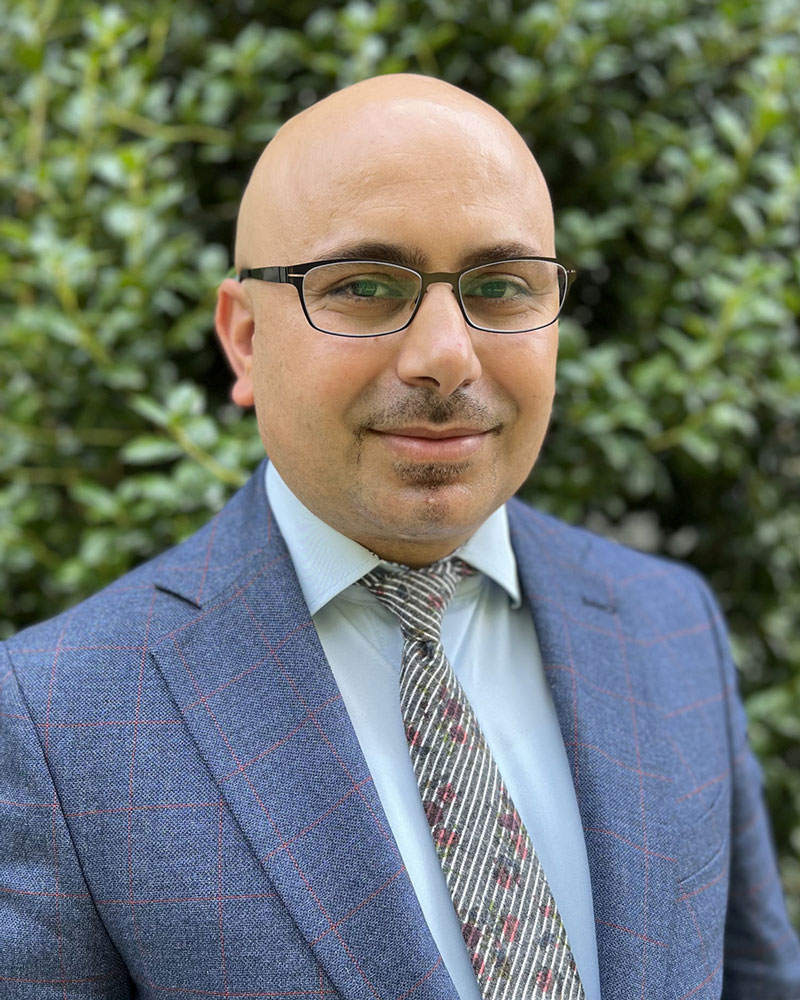Cognitive decline is a significant problem for South Carolina’s aging population. Statewide, more than 125,000 people are living with Alzheimer’s disease or dementia, according to the South Carolina Alzheimer’s Disease Registry, and that figure is projected to increase as a result of longer life expectancies and better diagnostics.
That’s one reason the University of South Carolina has prioritized its efforts to improve brain health across the Palmetto State. In USC’s Arnold School of Public Health, researchers are leading the charge to better understand how diet, exercise and intervention factor into the solution.
Meisam Arjmandi, Elizabeth Regan and Brie Turner-McGrievy are just three faculty whose expertise offers insight into a holistic approach to better brain health in South Carolina.
“Brain health is a pervasive interest of public health,” says Arnold School of Public Health Dean Tara Sabo-Attwood. “The work to enhance our understanding of brain health and how to preserve it is reflected across each of the disciplines of public health. The experienced researchers featured in this article provide a reflection of the talent and determination that the Arnold School brings to USC’s focus on brain health.”
Of sound mind
If you’ve ever chatted with a friend in a loud, crowded restaurant, a lively family gathering or even a busy workplace, you know how exhausting it can be. That feeling is called listening fatigue, says Meisam Arjmandi, an assistant professor of communication sciences and disorders. For adults experiencing hearing loss, that same strain doesn’t just make everyday conversation harder — it may also increase the risk of dementia, including Alzheimer’s disease.
The stakes are high; nearly 15 percent of U.S. adults — about 37.5 million people — report some trouble hearing, and the Alzheimer’s Association estimates dementia care already costs the nation more than $300 billion each year, a figure projected to double by 2050.
But the issue isn’t only about numbers — it’s something we all experience in daily life.

“Even with intact hearing, trying to hold a conversation in the middle of everyday noise can leave you fatigued and frustrated,” Arjmandi says. “You have to pay extra attention, and you have to recruit other resources in the brain to understand speech and be able to communicate. Sometimes you have to say, ‘Sorry, can you repeat that again?’ And when this happens often, that extra strain can affect multiple regions of the brain over time.”
About 60 percent of dementia cases can be attributed to nonmodifiable factors like age and family history — things beyond our control. But in the past few years, researchers have identified the modifiable risk factors that contribute to other cases. Consistently, hearing loss has topped the list across multiple studies.
“Around 7 to 9 percent of dementia cases are associated with midlife hearing loss,” Arjmandi says. “That’s huge. In fact, that’s the largest modifiable risk factor across all other factors, including lifestyle, alcohol consumption or physical activity.”
He and his colleagues have seen the association in their own studies as they work to better understand how hearing loss contributes to cognitive decline. Gradually, the constant extra effort to listen can lead people to withdraw from or even avoid social interaction. That isolation, combined with reduced stimulation of the brain’s auditory system, has been linked to higher rates of anxiety, depression and loneliness. Together, these changes can set the stage for faster cognitive decline.
“If I have hearing loss and a hard time accessing the whole range of sound and speech, then over time the part of my brain that’s responsible for processing speech and sound is going to get less stimulated and begin to atrophy,” he says. They have recently shown that this brain understimulation leads to shrinkage of white matter and gray matter in the auditory and non-auditory cortex.
Findings like these highlight the importance of early action. Arjmandi says the first step is to get an assessment. An audiologist can perform a pure-tone audiometry test along with measures of speech understanding in quiet and in noise to determine the type and severity of hearing loss. From there, treatment often involves an assistive hearing device such as a hearing aid or, in some cases, a cochlear implant if the benefit from hearing aids is limited.
Therapy can also help mitigate or prevent the anxiety, depression and loneliness that often come with hearing-related social isolation. And if family and friends are aware of the hearing loss, they can adapt their communication strategies to maintain social engagement. This could include using clear communication styles, facing the person directly to provide facial cues and reducing background noise. It is also important to encourage consistent use of hearing aids or cochlear implants.
Because hearing loss happens gradually, Arjmandi recommends regular screenings, particularly between ages 50 and 65, when the issue is most likely to begin. He notes that other factors, such as long-term noise exposure, can cause hearing problems to start even earlier.
There are still many unknowns, but Arjmandi and his USC collaborators hope to find answers. With a federal grant under review, his team proposes using novel behavioral tests and brain imaging tools to investigate how hearing loss affects specific areas of the brain, either directly or indirectly, through its links to social isolation, anxiety and depression, thus potentially contributing to cognitive decline in older adults.
Studying this is critical, he emphasizes, because South Carolina needs to prepare for its rapidly aging population. By 2030, it is estimated that one in five state residents will be 65 or older. And since hearing loss often appears years before cognitive decline begins, this window offers an important opportunity to intervene.
“If we understand that link between hearing loss and cognitive decline, we can take action in midlife to reduce the burden of dementia and Alzheimer’s disease across the country and even globally,” he says. “That would save billions of dollars, ease the suffering of millions of families and improve quality of life. It’s a challenge we are determined to tackle.”
Active body, active brain
Elizabeth Regan grew up in a family that valued physical fitness. When she became a physical therapist and saw how difficult it was for her patients to regain movement after major medical events, she was inspired to earn a Ph.D. in exercise science with a concentration in rehabilitation.
“I saw that people who end up with mobility impairments because of a stroke or other neurological concerns often have even more barriers than the average person to be able to exercise,” Regan says. “Combining my love of exercise with my knowledge of mobility impairments as a physical therapist came together nicely. I like how we can help people, even after rehab, lead active lives so they can engage in the things that are important to them more fully.”

Now a clinical associate professor in the Arnold School of Public Health, Regan has partnered with the university’s Brain Health Network to share her expertise by offering a structured exercise program for people with mild to moderate cognitive impairments. That partnership includes piloting both an in-person exercise program in Columbia and a virtual coaching program through the Brain Health Network’s Sumter clinic.
“We are providing them individualized programs but also with coaching support, the idea being that we are offering the right intensity and the right types of exercise to help them combat their cognitive decline,” she says.
Exercise’s physical benefits are well known, but research has shown it is critical for brain health, too.
“When we exercise, our muscles get blood flow, our muscles get nutrients. All of that happens with the brain as well,” Regan says. “We get better blood flow. We get more brain activity. And that allows for better connections.”
Beyond that, exercise lowers inflammation, even in the brain. That matters because chronic neuroinflammation is linked to neurodegeneration. Then there’s the mental aspect of physical fitness — challenging the body with new exercises or routines can engage the brain, too.
“Fitness, as we get older, reduces your likelihood of cognitive decline, so it has a protective effect,” Regan says. “And once you have signs of cognitive decline, exercise can reduce the decline and, in some cases, improve cognition.”
Like hearing loss, physical inactivity is a known modifiable risk factor for dementia. So are hypertension, obesity and diabetes, all of which can be improved with regular physical activity.
“We can’t control our genetics or some of the environment that we live in, but we can control some of our lifestyle factors, and exercising is one of them,” she says.
So how do you get started? Regan recommends checking out local fitness centers, like the YMCA, because they typically offer group classes as well as support when learning to use workout machines. Walking can be an option for those looking to ease into an active lifestyle since it doesn’t require any special equipment.
When it comes to intensity, moderate exercise is best for brain health. Three or four 45-minute sessions each week is ideal, but even one or two sessions each week can be beneficial. It is important to aim for both aerobic activity, which gets the heart rate up, as well as resistance exercise, which strengthens the muscles.
Regardless of when or how someone begins exercising, Regan emphasizes that it is never too late.
“One of the myths that I like to debunk is that, generally in our culture, we think slowing down is a normal part of aging, when for the most part, the things that we connect to normal age-related decline are actually about inactivity,” she says. “It’s because we’re not using it that we lose it, not because we’re getting older. You can build strength and endurance your entire life.”
Food for thought
If you’ve ever come home exhausted at the end of a long day, the idea of cooking something nutritious might feel daunting. While the occasional unhealthy convenience meal might not hurt, you likely know that reaching for these kinds of foods regularly can have a negative effect on your waistline, your blood pressure and other aspects of your physical well-being. But there is ample evidence that a poor diet also affects your brain.
Arnold School of Public Health professor Brie Turner-McGrievy is deputy director of USC’s SmartState Technology Center to Promote Healthy Lifestyles. Much of Turner-McGrievy’s research focuses on finding ways to help people eat healthier.

And how you eat can matter when it comes to your risk of Alzheimer’s disease. Then there’s vascular dementia, the second most common type of dementia after Alzheimer’s. Vascular dementia occurs when blood vessels in the brain are damaged. Many of its risk factors are linked to diet, including high cholesterol, high blood pressure, diabetes and obesity.
“Even if someone has a genetic predisposition, dietary changes can certainly reduce the risk or delay the onset of any sort of cognitive decline,” Turner-McGrievy says. “And epigenetic research has shown that food can influence gene expression related to things like inflammation and metabolism and brain function.”
In fact, inflammation is one of the biggest culprits when it comes to eating for brain health.
“In terms of what to eat, the main things are whole plant foods — so, fruits and vegetables. They’re really rich in polyphenols, which help reduce oxidative stress and inflammation,” she says. “Whole grains are also good because they contain fiber and help the gut microbiome, which is also linked to reductions in inflammatory markers. And nuts and seeds tend to be high in omega 3s. Those have anti-inflammatory properties.”
She adds that spices and legumes — think turmeric and beans — can also be beneficial.
On the flip side, eating saturated and trans fats can increase brain inflammation. So can added sugars, refined carbohydrates and processed red meats.
“In terms of what to avoid, ultra processed foods, things like packaged snacks and sugary cereals, are linked to increases in C-reactive protein, and that's a marker of inflammation.”
For those who like following a specific diet plan, Turner-McGrievy recommends the evidence-based MIND diet, which is designed to lower the risk of dementia and cognitive decline. MIND stands for Mediterranean-DASH Intervention for Neurodegenerative Delay because it is a combination of the hearth healthy Mediterranean and hypertension-lowering DASH diets.
Recent research has shown that those who follow MIND are, on average, 9 percent less likely to develop dementia.
“They also found that those who improved their adherence to the MIND diet over 10 years had a 25 percent lower risk of dementia compared to those whose adherence declined,” she says.
So, what’s the secret to changing your diet and sticking with it? Turner-McGrievy says there are a number of meal planning and diet-tracking apps as well as meal delivery services, such as Purple Carrot, that can do some of the heavy lifting. For people with busy schedules, slow cooker and Instant Pot meals are an easy solution for dinner. Sheet pan meals — where the whole meal is roasted together on one pan — are another quick way to whip up something nutritious.
At the end of the day, the key is to get more fruits and vegetables. Even when someone doesn’t want to commit to going fully vegetarian, approaches such as Meatless Mondays or eliminating processed red meats can make a difference.
“If you look at the epidemiological studies of people who are following plant-based diets, they tend to have lower risk of heart disease, diabetes and certain cancers compared to non-vegetarians,” she says. “Since all of those conditions are associated with cognitive decline, that’s a potential benefit of a more plant-based style of eating.”

